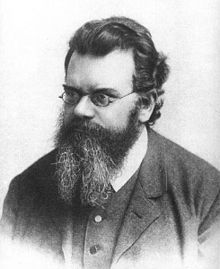Ludwig Boltzmann
Ludwig Eduard Boltzmann (February 20, 1844 – September 5, 1906) was a well-known Austrian physicist, member of the Impreial Austrian Academy of Sciences. He was considered to build the foundations for scientific fields including statistical mechanics and statistical thermodynamics. He was one of the major contributors for atomic theory while the atomic model was still highly controversial. Besides Max Planck, he was also the first person who had ideas for quantum theory.
Ludwig Boltzmann | |
|---|---|
 Ludwig Eduard Boltzmann (1844-1906) | |
| Born | February 20, 1844 |
| Died | September 5, 1906 (aged 62) |
| Nationality | |
| Alma mater | University of Vienna |
| Known for | Boltzmann constant Boltzmann equation Boltzmann distribution Stefan–Boltzmann law |
| Scientific career | |
| Fields | Physics |
| Institutions | University of Graz University of Vienna University of Munich Leipzig University |
| Doctoral advisor | Josef Stefan |
| Doctoral students | Paul Ehrenfest Gustav Herglotz |
Biography
changeChildhood and Education
changeBoltzmann was born in Vienna, the capital of Austrian Empire. His father, Ludwig George Boltzmann, was a tax official. His mother, Katharina Pauernfeind, came from Salzburg. At childhood, his parents invited a private tutor to teach him. He then attended high school in Linz. When he was 15 years old, his father died.
Since 1863, Boltzmann studied physics at the University of Vienna. Some of his teachers were Johann Josef Loschmidt, Joseph Stefan, Andreas von Ettingshausen and Jozef Petzval. Boltzmann received his doctorate in 1866. In 1867, Boltzmann was already a university lecturer. After earning his doctorate, Boltzmann worked for two years as Stefan's assistant. Stefan then introduced him James Clerk Maxwell's work.
Career
changeIn 1869, at age 25, he was appointed full professor of mathematical physics at the University of Graz. In 1869, he spent several months working with Robert Bunsen and Leo Königsberger at Heidelberg. In 1871, he worked with Gustav Kirchhoff and Hermann von Helmholtz in Berlin. In 1873, Boltzmann went to the University of Vienna as a professor of mathematics and stayed there until 1876.
In 1872, he met Henriette von Aigentler, a math and physics teacher in Graz. In 1876, they got married and had three daughters and two sons. Boltzmann returned to Graz as head of the Department of Physics. About 14 years in Graz, he developed his concept of natural statistics. In 1885, he became a member of the Imperial Austrian Academy of Sciences and in 1887, he became President of the University of Graz.
In 1890, Boltzmann became head of the department of Theoretical Physics at the University of Munich in Germany .
In 1893, Boltzmann succeeded Joseph Stefan as Professor of Theoretical Physics at the University of Vienna.
Physics
changeBoltzmann was a classical physicist, but had a great influence on the modern physics including statistical mechanics and statistical thermodynamics. The Boltzmann equations are key ideas for non-equilibrium thermodynamics and reversible processes. Boltzmann also has great merit in formulating and defending the second law of thermodynamics, developing the definition of entropy from a purely statistical point of view.
The entropy equation, engraved on his tombstone, is Boltzmann's great scientific achievement:
Boltzmann Equation
changeThe Boltzmann equation describes the dynamics of an ideal gas.
Other websites
change- Ruth Lewin Sime, Lise Meitner: A Life in Physics Chapter One: Girlhood in Vienna gives Lise Meitner 's account of Boltzmann's life and career.
- Ludwig Boltzmann Archived 2008-09-29 at the Wayback Machine, University of Vienna.
- Ali Eftekhari, Ludwig Boltzmann (1844–1906)
- Scienceworld biography
- Ludwig Boltzmann's Gravesite